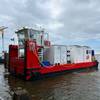In a new white paper, Consolidation in the liner industry, Drewry consider the merits, and pitfalls, of M&A activity within container shipping, but cautioned that strategy needs to be carefully through through.
Container shipping remains remarkably fragmented, with the top five operators accounting for less than half the global market. This presents considerable opportunity for further consolidation. Until recently, the industry had experienced a 10-year lull of M&A activity following a flurry of takeovers in the early 2000s.
Yet in the past 12 months four major deals have taken place involving several major shipping lines which have led people to question whether this presages a new trend of further industry consolidation.
The financial pressure on industry players, and in particular on weaker carriers, is intensifying daily as rates plumb new depths. Consolidation may be a route to survival for some, allowing lines to combine to create scale and to realise synergies. As stronger carriers have shown, however, it is not the only route to scale.
Both Maersk and Hapag-Lloyd have used acquisition as an engine of growth, whereas MSC has relied entirely on organic growth and prior to its acquisition of APL, CMA-CGM had complemented organic growth with a number of small acquisitions.
The benefit to the industry as a whole is considerably greater if lines pursue growth through acquisition rather than continuing to build new and larger tonnage, which the industry does not need.
On the other hand, consolidation as a strategy for individual shipping lines entails considerable risk that the targeted benefits will not be achieved. Much depends on how effectively the task of consolidating the two businesses is managed.
Drewry identifies several key learning points for any shipping line considering consolidation with another carrier:
Consolidation between two container shipping lines should achieve cost savings, through delivering synergies and longer term strategic advantage
Consolidation yields greater benefit if the geographical footprint of the two companies is complementary, rather than resulting in additional volumes in the same trades
The main cost savings come from economies of scale benefits as well as opportunities for smarter operations with increased volumes – e.g. improved network utilisation and lower container and imbalance costs
While additional volumes can support employment of larger vessels, in many cases scale benefits in ship systems are already being achieved through Alliance membership
A key objective during any consolidation must be to retain the customers of the two lines – loss of volumes or market share can cancel out the cost benefits obtained
The challenge of merging two organisations with potentially different cultures and management styles should not be underestimated
There will be significant one-off costs associated with combining the two businesses
Planning and execution of mergers requires careful project management which can stretch resources – external expertise can alleviate this by providing additional skill sets
People are critical to the transformation process and without a fully committed team there is a risk of customer attrition and project delay. It is essential to motivate both those chosen to remain in the future business together with those who are only needed through the transition phase
Communication with all involved parties, including staff, customers, suppliers and partners, is vital throughout the process.










